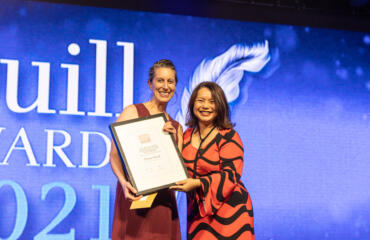A Victorian space manufacturing start-up is on a mission to find a partner and more funding that will allow it to jointly stage the state’s first commercial rocket launch.
NextAero, based in Melbourne’s south-eastern suburbs, has developed a rocket engine using additive manufacturing – the 3D printing of metal materials.

Dr Dominic Tan (front) and fellow NextAero co-founders Graham Bell, Thomas Knast and Joel Weightman (left to right) at the Monash University Clayton campus. Photo: NextAero.
“We’ve built and designed a prototype rocket engine,” says Dr Dominic Tan, an aerospace engineer and co-founder of the business.
The engine was first test-fired in 2017 on farmland near Kyneton, in the Macedon Ranges north-west of Melbourne.
The demonstration took place “to showcase the capabilities of additive manufacturing,” as its founder says, but it also propelled NextAero to greater heights.
Tan says being able to buy and attach a rocket engine that requires little research and development was a strong selling point for potential partners, especially after the successful test.
“From that point we thought, ‘We might be onto something. There might be a deeper idea, or a missing gap in the market.’ ”
NextAero has since been accepted into Monash University’s accelerator program, which exists to promote entrepreneurial ideas. Tan says the company’s experiences led the decision to “develop a prototype that is flight-ready and able to launch”.
Tan credits successful SpaceX launches in the US for convincing him that private companies can develop a launch capability.
In Australia, that belief is embodied by companies like Gilmour Space Technologies and Black Sky Aerospace. Both are privately owned and Queensland-based.
Australian launches will occur monthly within five years, they told the ABC in April.
Gilmour Space Technologies hopes to launch a sub-orbital rocket (reaching space but not orbit) later this year, whereas Black Sky Aerospace has already notched up a successful launch, last November.
According to a March 2018 review of the nation’s prospective space capabilities, Australia’s space industry is expected to triple its economic ‘footprint’ over the next 10 years, delivering $10 billion to $20 billion to the economy over that period.
The boost could provide an extra 10,000-20,000 jobs across the country and opportunities for self-starters like NextAero, the preview predicts.
The way Tan sees it, the country today is still sitting on the launch pad: “Initially within Australia there hasn’t really been a space industry to get involved in,” he says.
Under Tan’s ideal career trajectory, he would stay in Australia and pursue a career in space manufacturing without moving to areas such as the US or Europe, where space programs are more advanced.
Robert Mearns, a systems engineer on the SkyHopper space telescope project at Melbourne University, also aspires to a career in the Australian space industry. The SkyHopper project is aiming to build and launch an orbiting telescope that will collect valuable scientific data. According to Mearns, that process involves a “nanosatellite” sitting 500km above the Earth with a telescope aboard taking infrared imagery.
SkyHopper will scan the heavens for more planets in other ‘solar’ systems which have at least one brown dwarf (a sub-stellar space object bigger than Jupiter but smaller than a star).
“There really is no Australian spacecraft outside of commercial telecoms,” says Mearns. He hopes SkyHopper’s success will help change that reality.
As a 28-year-old, Mearns is conscious of the challenges young people face as they enter the industry. “Australia has a big problem with people studying and leaving to work in other countries because they’re a better option,” he says.
Ambitious projects developing space technology require plenty of resources. “It’s quite difficult to get money for space technology in Australia,” says Mearns. Past funding, he points out, has been available for astrophysics research but not necessarily space technology.

Robert Mearns, systems engineer on the SkyHopper research project at the University of Melbourne.
Tan has experienced similar challenges. “Unfortunately, [investors] often look for huge returns within five to 10 years because that’s the lifetime of their funds,” he says.
“[In Australia] we’re still trying to figure out how to support the start-ups while also supporting the extremely capital-intensive nature of the projects.”
In late 2018, at a ceremony in South Australia to mark the establishment of the Australian Space Agency (ASA), the Morrison Government committed $41 million as an initial investment towards reaching the ambitious target of $10 billion to $12 billion in value by 2030.
Tan says the agency’s current focus is on Earth observation but he would like to see a bigger commitment to the “nitty-gritty” of building a national space capability.
“It all seems kind of ephemeral to me right now. It’s these grand ideas but no one knows what’s going to work in the long run,” he says.
But Conrad Pires, CEO and co-founder of Picosat Systems – a Perth-based provider of small satellite solutions – thinks the agency needs time to develop.
“The ASA is currently a small team that’s less than one year old. I believe that as they grow over time, so will their ability to continue to support commercial space activities.”
The Department of Defence addressed Australia’s development in a paper released last March at the Emerging Disruptive Technology Assessment Symposium held in Perth.
Quoting from that paper, “The Defence policy position in relation to a domestic launch capability is that of a buyer of services but not … a funder of development.”
Such an attitude gives little succour to companies such as NextAero seeking that vital but so far missing ingredient – opportunity.
Another quote from the same paper underscores the department’s ambivalence when it comes to providing the spark that will ignite the nation’s long-dreamt-of extraterrestrial leap.
“It was considered that a domestic launch capability would be a ‘nice to have’ capability; the key question is whether you actually need it.”



